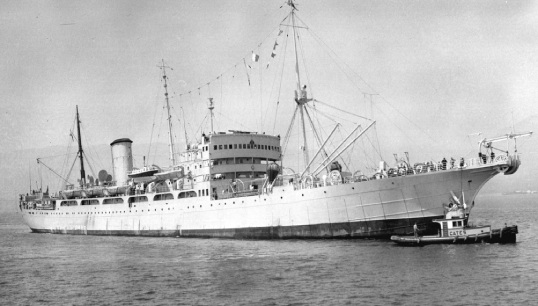Monarch

Built for purpose
When completed in February 1946, as HMTS (His Majesty's Telegraph Ship) Monarch, the vessel was the largest cableship in the world – with the ability to carry up to 2,500nm of deepsea telegraph cable in four 41ft-diameter cable tanks.
Significantly larger than all previous General Post Office (GPO) cableships, the 8,541grt Monarch had been ordered by the government to replace the 5,533grt Faraday – which had been the victim of a Second World War German air attack off the coast of Wales in March 1941 – but its launch had been delayed by the war.
The build
Built at the Swan, Hunter & Wigham Richardson yard in Wallsend, Monarch incorporated many special and innovative design and equipment features, and was the first cableship to have all-electric cable machinery. Diesel-electric or turbo-electric drive had been suggested, but 'after careful consideration' it was agreed that the ship would be powered by two three-cylinder triple expansion engines developing 4,500hp and driving twin screws.
After comfortably achieving 14.5 knots on builders' trials, Monarch conducted successful cable laying trials off Scotland and the Scilly Isles before working on cables between the UK, the Netherlands and Denmark.
Transatlantic trailblazer
In 1952, Monarch laid a series of cables for the US Air Force, from Cape Canaveral in Florida to the Bahamas, and on to Grand Turk, the Dominican Republic and Puerto Rico.
Between 1955 and 1965, Monarch did the bulk of the work to lay the 2,240-mile TAT-1 transatlantic telephone cable between Oban, Scotland, and Clarenville, Newfoundland, in a joint British, American and Canadian project. Monarch was the only cableship capable of carrying out the work to lay 1,500nm of cable in one piece across the deepest part of the Atlantic.
It was during this project that Monarch helped the UK Meteorological Office to complete its State of the Sea guide for seafarers, by supplying some much-needed photographs of force 11 and 12 sea conditions.
Connecting the world
Monarch also worked on laying the second transatlantic telephone cable, TAT-2, in 1959, the HAW-1 cable between the US mainland and Hawaii in 1957, and Canada's transatlantic CANTAT-1 cable in 1961.
Between 1962 and 1963 Monarch worked with two Cable & Wireless ships to lay the 9,400-mile Commonwealth Pacific Cable System (COMPAC) that connected Canada with New Zealand and Australia.
In 1968 Monarch helped to complete sections of the SAT-1 telephone cable between South Africa and Portugal and in the following year the ship's prefix changed from HMTS to CS when the GPO's status went from being a government department to a statutory corporation.
The later years
Monarch was sold to Cable & Wireless in October 1970 and renamed CS Sentinel. Based in Bermuda, the ship then became used mainly for Atlantic cable maintenance and repair, as well as trials of the Scarab remote submersible for surveying, recovering and re-burying existing buried cables, before being sent to Blyth for scrapping in October 1977.
Monarch fact file
Which historic cable did Monarch help to lay?
Monarch helped to lay Tat-1
When was Monarch completed?
Monarch was completed in 1946
Who was Monarch sold to in 1970?
Monarch was sold to Cable & Wireless in October 1970
Contribute
Are you knowledgeable about this vessel?
Submit your contribution to this article to our editorial team.
Write to usView more ships of the past
HMS Beagle
Launched 200 years ago, HMS Beagle has been described as one of the most important ships in history – thanks to the observations on evolution and natural selection that its famous passenger Charles Darwin made during a five-year voyage around the world between 1831 and 1836.
Common.ReadMoreHMS Beagle
Megara
Originally constructed as an oil tanker in 1929, the Dutch ship Megara went on to become one of the first specialist liquefied petroleum gas (LPG) carriers only five years later.
Common.ReadMoreMegara
Malakand
Launched in November 1918, the Malakand was a sistership to three other vessels and was fitted to train cadets until the shipping slump of the 1920s. With an uneventful early career, the Malakand later became the victim of Liverpool's May Blitz in 1941.
Common.ReadMore